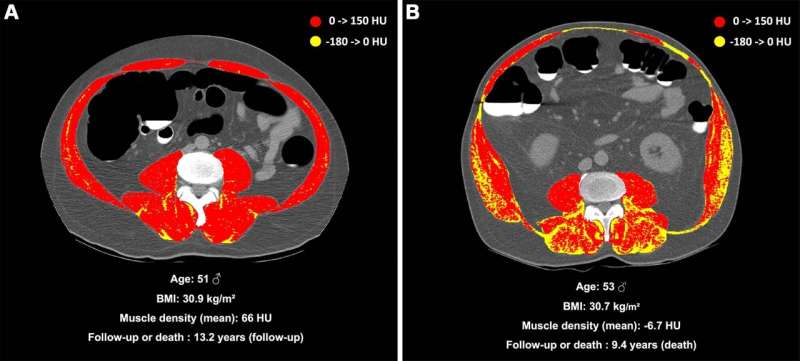This article has been reviewed according to Science X's editorial process and policies. Editors have highlighted the following attributes while ensuring the content's credibility:
fact-checked
peer-reviewed publication
trusted source
proofread
Muscle fat linked to higher mortality risk

Asymptomatic adults with a high accumulation of fat in their muscles, known as myosteatosis, are at an increased risk of major adverse events and death, according to a study published in Radiology.
One of the methods used by physicians to estimate body fat in patients is the body mass index (BMI). Since BMI is calculated using only a patient's height and weight, it's not an accurate reflection of body composition because patients with similar BMIs can have vastly different co-comorbidities and levels of health risk.
A more thorough reflection of body composition can be obtained from abdominal CT or MRI scans, which can reveal a variety of different fat accumulations. The medical community primarily focuses on visceral fat, which is fat that accumulates around abdominal organs, and liver steatosis, which is a high amount of fat in the liver.
Another form of fat accumulation is myosteatosis, which occurs when fat accumulates in the muscles. Since myosteatosis is usually found in patients who are already sick and undergoing medical imaging for another illness, little is known about its health risks in asymptomatic patients.
"To date, medical imaging with CT or MRI remains the gold standard to evaluate myosteatosis," said study co-author Maxime Nachit, M.D., Ph.D., a post-doctoral researcher at the Institut de Recherche Expérimentale et Clinique at UCLouvain in Brussels, Belgium.
For this reason, Dr. Nachit and colleagues sought to identify the association between myosteatosis and mortality risk, while simultaneously studying visceral fat, liver steatosis, myopenia (muscle wasting) and obesity.
In the retrospective study, the researchers used an AI tool to extract body composition metrics from abdominal CT scans on asymptomatic adults who had undergone a routine screening for colorectal cancer between 2004 and 2016. Incidences of major adverse events (such as heart attack, stroke, or aneurysm) and death were recorded during an average follow-up period of 8.8 years.
Of the 8,982 adults included in the study, a total of 507 died during the follow-up period. Myosteatosis was associated with an increased risk of major adverse events and was found in 55% of the study participants who died. The absolute mortality risk at 10 years in individuals with myosteatosis was 15.5% compared to obesity (7.6%), liver steatosis (8.5%) or myopenia (9.7%).
While the presence of other health factors, such as visceral fat and liver steatosis, were also associated with a higher mortality risk, myosteatosis remained the highest.
"Interestingly, the relationship was independent from age or markers of obesity such as BMI," Dr. Nachit said. "In other words, this means that fat accumulation in the muscles is not merely explained by being older and/or having fat overload in other locations of the body."
The mortality risk of patients with myosteatosis was comparable to the mortality risk associated with smoking or having type 2 diabetes. Despite the growing evidence of the risk factors that are associated with myosteatosis, it is a condition that is still overlooked in the medical community.
Future studies could help determine whether myosteatosis is solely a biomarker of poorer health status or whether it is causally associated with an increased risk of death, according to Dr. Nachit.
"We are witnessing the onset of 'personalized medicine,' whose aim is to tailor medical management at the individual level based on a constellation of information such as genetics, medical history, physical characteristics, complex and large-scale molecular evaluation, etc.," Dr. Nachit said.
"Here, we show that myosteatosis—a parameter retrievable from medical images performed routinely in hospitals—is a robust indicator of an individual's mortality risk at a relatively short term."
The study was conducted in collaboration with the University of Wisconsin-Madison, where patients were enrolled and scanned under the leadership of co-author Perry J. Pickhardt, M.D. The AI software used in the study was developed in the laboratory of co-author Ronald M. Summers, M.D., Ph.D., at the National Institutes of Health Clinical Center.
More information: Maxime Nachit et al, AI-based CT Body Composition Identifies Myosteatosis as Key Mortality Predictor in Asymptomatic Adults, Radiology (2023). DOI: 10.1148/radiol.222008


















